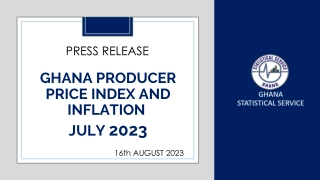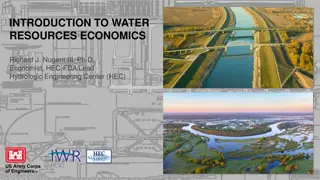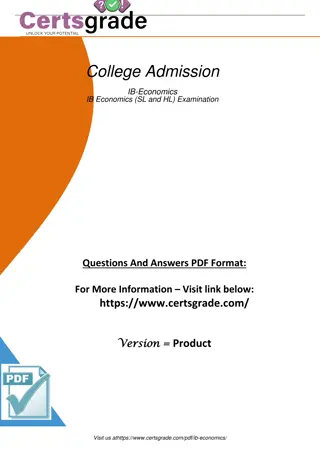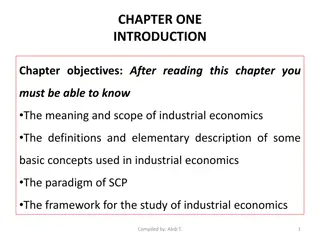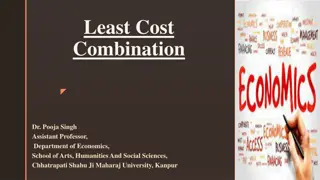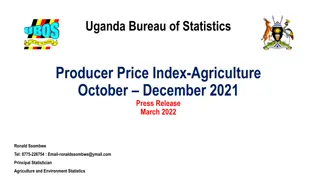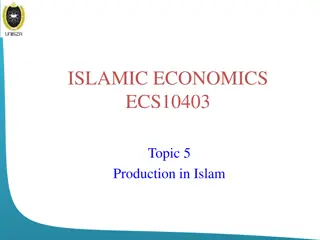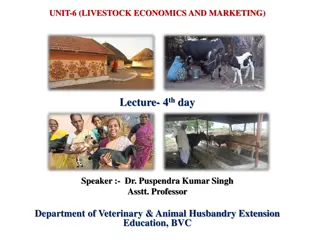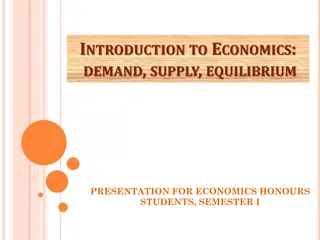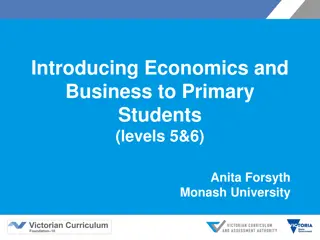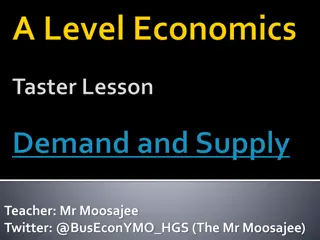Understanding Producer Economics: Concepts and Strategies
Explore key concepts in producer economics such as supply, cost minimization, revenue maximization, and cost structures. Discover the importance of time frames, input-cost relationships, and factors affecting average variable costs in the producer's decision-making process.
Download Presentation

Please find below an Image/Link to download the presentation.
The content on the website is provided AS IS for your information and personal use only. It may not be sold, licensed, or shared on other websites without obtaining consent from the author. Download presentation by click this link. If you encounter any issues during the download, it is possible that the publisher has removed the file from their server.
E N D
Presentation Transcript
Roadmap: from inputs to supply Just like the consumer, whose goal is to get the best possible satisfaction given consumer s budget, we will map out what that best possible is for the producer Recall the law of diminishing marginal return to an input This law helps us understand how producers behave with respect to the inputs they hire
Time frame matters We distinguish initially between the short run and the long run. These time frames are defined by the degree of flexibility an entrepreneur or manager has in her production process. Short run: a period during which at least one factor of production is fixed. If capital is fixed, then more output is produced by using additional labour. Long run: a period of time where all factors of production can be adjusted. Very long run: a period sufficiently long for new technology to develop. We will focus (for now) on the short-run
Objective of producers What is the ultimate objective for the producer? Revenue maximization Profit Cost minimization Revenue maximization is the flipside of cost minimization. That is, by minimizing the cost, producers will maximize their revenues. Cost minimization tends to be the leading them in supply derivation.
Recall from Lesson 4: relating inputs to costs The ultimate goal of the owner of Black Diamond Snowboards is to make profit, and for this he must figure out how productivity translates into cost. The first step is to relate inputs to costs: o Incurred costs for fixed inputs (garage, tools, etc.) will translate into fixed costs o Incurred costs for variable inputs (workers, etc.) will translate into variable costs o Total costs are the sum of variable costs and fixed costs We use the terms fixed, variable, and total costs to define the cost structure of a firm. We now switch to the discussion about costs
Average variable cost (AVC) Producers consider two more types of costs as part of their cost structure: the average variable cost and the marginal cost Let s begin with the Average Variable Cost (AVC) o AVC tells the producer what it costs to produce an average unit of the good AVC has the following pattern first, it decreases and then it increases. Why is that? o The variable cost, which represents the cost of labour, is constant per unit of labour, because wage paid to each worker does not change. o However, productivity of each worker varies o When a producer hires the first few workers, they become more productive, because they have less down time in switching between tasks. This means that the labour costs per output produced declines. o At some point, however, the law of diminishing returns sets in: As before, each additional worker is paid a constant amount, but as productivity declines, the labour cost per snowboard increases.
Marginal cost Now consider the Marginal Cost (MC) o Marginal cost is the cost of producing each additional unit of output Behaviour of the marginal cost is determined by the marginal product. Why is that? o When the MP of an additional worker exceeds the MP of the previous worker, this implies that the cost of the additional output produced by the last worker hired must be declining. To summarize: o If the marginal product of labour increases, then the marginal cost of output declines o If the marginal product of labour declines, then the marginal cost of output increases.
More on marginal cost Relating MC and MP: when the marginal cost reaches a minimum at the output level that s when the marginal product reaches a maximum.
Inputs Cost Supply We are now ready to derive producer s supply What the supply curve would reflect is the decision-making process of the firms, which would be producing in such a way as to maximize their profits.
Explaining the graph on slide 11 1. Point A: At this point, price is greater than the ATC, so it is profitable to produce. 2. Point B: At this point, price is still greater than the ATC, it continues to be profitable for the producer to keep producing. 3. Point C: At this point, price is equal to the minimum of ATC. This is the break-even point producer makes zero profits. 4. Point D: At this point, producer is not making any profits, but still covers variable cost per unit and some fixed costs I. Should they shut down? No, not yet because they would incur the full fixed cost. II. Minimizes loss this decision is similar to ignoring sunk costs cost that is incurred and cannot be changed should have no effect on the decision. 5. Point E: At this point, the producer shuts down production as not able to cover variable costs.
Composition of the supply curve Graph on slide 10 maps out the supply curve. The Pink supply curve has two parts: o Part 1: it traces the upward MC portion reflects the profit maximizing output o Part 2: it is vertical i.e., inelastic what does it represent?
A few words about behaviour of average costs The average total cost is the sum of the fixed cost per unit of output and the variable cost per unit of output. Typically, fixed costs are the dominant component of total costs at low output levels, but become less dominant at higher output levels. Unlike average variable costs, note that the average fixed cost must always decline with output, because a fixed cost is being spread over more units of output. When the ATC curve eventually increases, it is because the increasing variable cost component eventually dominates the declining AFC component.
Fixed Cost Spreading Online grocery delivery services charge a flat fee to deliver groceries. Why do customers have an incentive to order a lot of groceries? They want to spread the fixed cost of delivery over many items so that their AFC decreases.
Review: from inputs to supply This video offers a brief summary of the material covered in slides 2-14 of this lesson. This review can help solidify presented concepts. Deriving the supply curve
We have derived the supply curve The law of supply states that as price increases, quantity supplied increases. Watch Why is there a direct relationship between price and quantity supplied?
Intuition for supply curve Diminishing marginal returns (DMR) reflects the idea that equal increases in the amount of input used leads to smaller and smaller increases in output that is produced from an input. How exactly does DMR imply an upward sloping supply curve? o The 1st unit of output can be produced with relatively small increases in input, firms would be willing to produce these first units for a relatively low price. o As production increases then increasingly large amounts of inputs are required. If price is low, only those firms that have low costs would produce the good in the market. As price increases, other firms can enter and high cost firms will produce the goods in the market
Minimum willingness to accept Law of supply is based on price driving quantity. What about if quantity supplied drives price? Then supply reveals the minimum willingness to accept. How much would firms be willing to accept to produce Q1? There is one firm that would be willing to accept P1, but others would be willing to accept more than P1, but P1 is the minimum. At what price would producers be willing to produce Q2?
Change in quantity supplied vs. supply Just as the case with demand, it is important to distinguish between changes in quantity supplied (movement along the supply curve) as opposed to changes in supply (shifts of the supply curve) This video provides a great visual of the differences.
Factors affecting supply This video examines other influences that underlie supply curves. What are those influences?
Learning Outcomes Producers objectives Average variable and marginal costs Derivation of the supply curve Intuition behind the supply curve Law of supply Factors affecting supply


